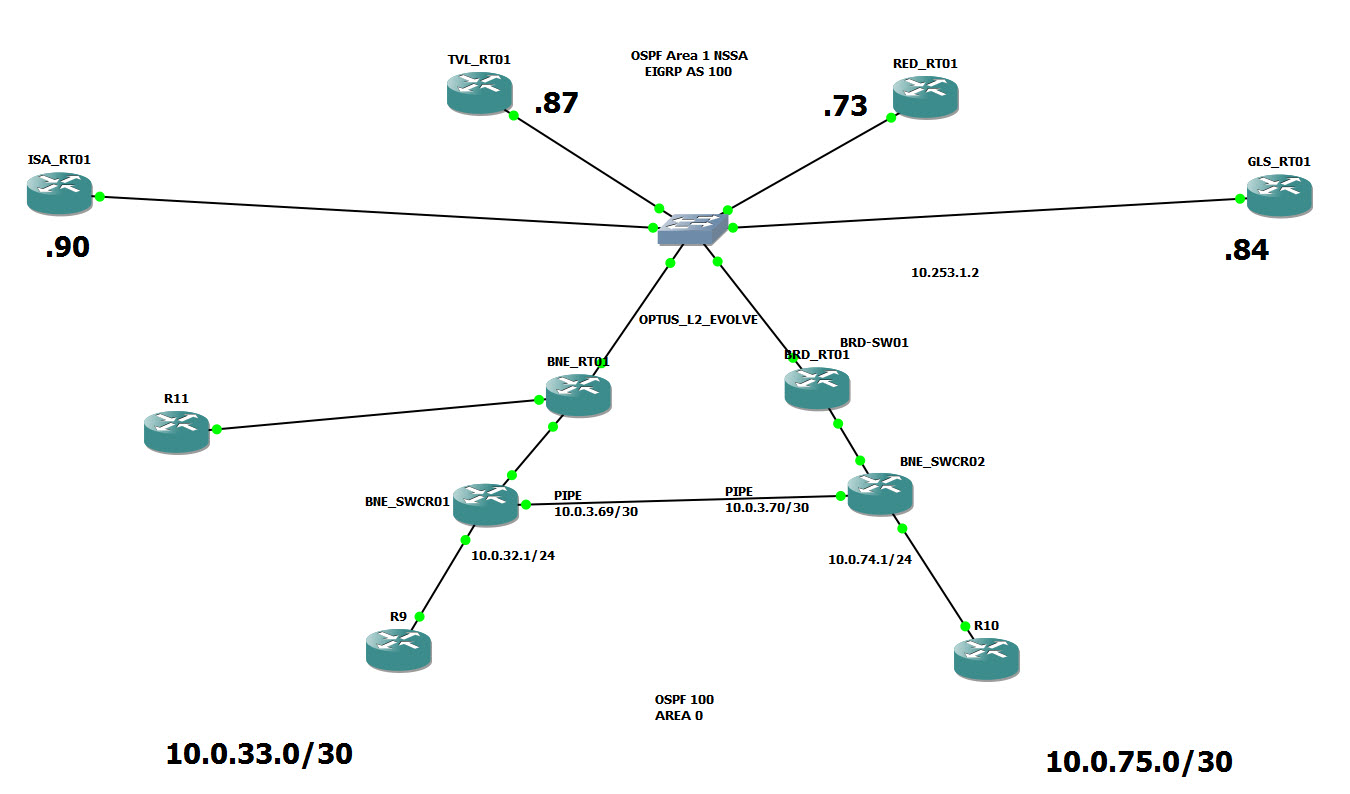- Cisco Community
- Technology and Support
- Security
- VPN
- Hub to Hub communication in Dual cloud DMVPN?
- Subscribe to RSS Feed
- Mark Topic as New
- Mark Topic as Read
- Float this Topic for Current User
- Bookmark
- Subscribe
- Mute
- Printer Friendly Page
Hub to Hub communication in Dual cloud DMVPN?
- Mark as New
- Bookmark
- Subscribe
- Mute
- Subscribe to RSS Feed
- Permalink
- Report Inappropriate Content
03-10-2013 03:31 PM - edited 02-21-2020 06:45 PM
Hi guys,
This is a gns3 lab example, but this a cut down version of my production network in real life
I have the following topology;

This is a dual hub, dual cloud environment, subnets 10.0.251.0/24 and 10.0.252.0/24
Each spoke (ISA,TVL,RED and GLS) has two tunnels configured
We have our production Data center hanging off bne-swcr01 and our DR data center off bne-swcr02
There are users also hanging off these two switches (in real life these are HP Procurve switches, soon to be Cisco)
I have a 10Gbps dark fibre connection between bne-swcr01 and bne-swcr02 mainly for replication but also provides connection to internet (R11 firewall) for users hanging off bne-swcr02.
The DMVPN network is running EIGRP (bne and brn-rt01 and above including all spokes)
Everything below is running OSPF
EIGRP is redistributed into OSPF
an EIGRP summary is configured on the Hubs sending a default to spokes, it has a higher AD than the network default below.
a network default route is learnt from R11 (firewall)
The two uplinks to the DMVPN cloud from bne-rt01 and brn-rt01 are 100Mbps
I want to configure a backup 100Mbps connection between the two hubs in the case of a dark fiber failure and my initial thoughts were a single IPSEC site to site tunnel, but the problem seems to lie in the configuration of the interesting traffic statement, as it really needs to be a permit ip any any rule, but it won't form a neighborship unless i am specific in the source and destination subnets(and they are mirrored)
If the pipe fiber fails (dark fiber 10gbps) traffic from the hosts hanging off bne-swcr02 will still need to get to the internet so how do i configure an interesting traffic statement for that other that ip any any?
Im hoping there is something i can do in the DMVPN world to solve this, it will be cleaner and easier to implement i would imagine.
Configurations follow in txt files
- Labels:
-
DMVPN
- Mark as New
- Bookmark
- Subscribe
- Mute
- Subscribe to RSS Feed
- Permalink
- Report Inappropriate Content
03-11-2013 08:49 AM
Warren,
You can configure a p2p VTI (any any proxy IDs) or GRE tunnel (with a small loss of MTU but with added flexability) with IPsec protection or have one hub be a spoke for the other.
There's quite a few differet possibilities there, I guess from routing perspective it's best you also run a routing protocol between the sites and have them know about specifc subnets and not only summaries ;-)
M.
- Mark as New
- Bookmark
- Subscribe
- Mute
- Subscribe to RSS Feed
- Permalink
- Report Inappropriate Content
03-24-2013 08:26 PM
So i ended up making the brn router a spoke of bne, i created a second tunnel interface on brn and pointed it to bne as the NHS, and redistributing routes over from OSPF into EIGRP at the BRN site, worked well, one thing i am having touble with is redistibuting the default which is learned from bne over the tunnel (the summary) into OSPF, it just won't go, at the moment i have a floating static default pointing to brn-rt01 in the event of a "PIPE" failure, bit of a bandaid solution though....your thoughts?
Discover and save your favorite ideas. Come back to expert answers, step-by-step guides, recent topics, and more.
New here? Get started with these tips. How to use Community New member guide